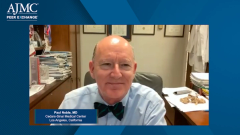
ILD Clinical Trials Continued
Daniel Culver, DO, concludes the clinical trial discussion by elaborating on Dr Highland’s assessments of the data that support the use of nintedanib, pirfenidone, and tocilizumab when treating IPF, PF-ILD, and SSc-ILD.
Episodes in this series

Ryan Haumschild, PharmD, MS, MBA: We had a great analysis of the trials. We don’t need to jump into that further. But how many patients were involved in these trials, and do you feel like the data are robust enough to make therapeutic decisions, based off of all the great information Dr Highland shared?
Daniel Culver, DO: Thanks, Ryan. The data are variable, depending on which disease you’re talking about. IPF [idiopathic pulmonary fibrosis] is the cleanest phenotype, and it’s been the most well studied. IPF trials in the last 2 decades have pivoted from focusing on anti-inflammatory agents, and I think that got put to bed for good about 15 years ago, to focusing on antifibrotic agents, for the most part. Pirfenidone, the trials were going on for quite some time, longer than they were for nintedanib. So for pirfenidone, if you take all the CAPACITY trials plus the ASCEND trial, you’re talking about several thousand people. For nintedanib, if you take the TOMORROW trial, plus the 2 INPULSIS studies, and these are the main registrational trials, you’re talking about around 1300 patients. Of course there are a fair bit of real-world data that have come out since those trials that also inform our thinking about these. If you look at both the main registration trials for nintedanib and pirfenidone, I think the story is roughly similar for both of them. As Paul said, they both focus on forced vital capacity [FVC], they measure them both a little differently. The attenuation of decline in forced vital capacity for nintedanib in the INPULSIS trials is about 50% compared to placebo. It goes from the 220 to 240 mL range down into the 115 to 120 mL range with treatment. With ASCEND, it’s more a question of the proportion of patients who progressed past a certain threshold decline of FVC of 10%, and the hazard ratio for that is around 0.6. So both of them appear to be effective at arresting the decline in FVC.
Then there are some secondary end points, like the risk of acute exacerbations, where you see variability between some of the trials. Neither of them are really powered to look at mortality, but if you combine several of them, or you look at some of the real-world data, I think there are some suggestions of improvement of mortality. Some of the real-world data are not exactly the same. There are registries in Europe that suggest perhaps a really big shift in the risk of mortality. There’s a large registry in the United States, the IPF-PRO [Idiopathic Pulmonary Fibrosis–Prospective Outcomes], that doesn’t show quite the same mortality signal. Taking all those on average, I think these agents do slow the progression of the disease. They probably attenuate major secondary end points like acute exacerbation, which we know is a marker of badness, they attenuate the risk of hospitalization. There is some association with quality of life in some of the data that we have, and there’s probably a push for mortality, maybe not quite as strong as what you see with the change in FVC. But in general, I’ll rest on what I said before, which is I have more boring visits than I used to have. I think the needle has been moved, probably just not far enough yet.
Ryan Haumschild, PharmD, MS, MBA: It’s a great callout on the boring visits, and I really like how you hit on the registries. Because I think more and more we’re relying on the real-world evidence and trying to look to these registries to make treatment decisions. I think one of the things that would be helpful is also if payers look at the data around registries as they’re trying to make decisions, as well as providers, because I think there’s a lot of evidence there that has allowed us to make more timely decisions. While we always love randomized clinical controlled trials, sometimes the readouts take a while. How do we provide better management sooner leveraging all that evidence that’s available? That’s a great callout.
This transcript has been edited for clarity.
Newsletter
Stay ahead of policy, cost, and value—subscribe to AJMC for expert insights at the intersection of clinical care and health economics.









































